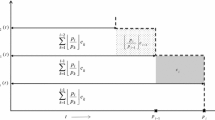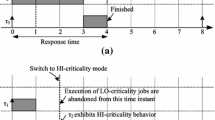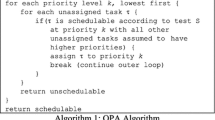Abstract
Exact feasibility conditions for real-time system under preemptive fixed-priority systems are NP-hard and attempts have been made to lower the computation cost of such tests by restricting the set of scheduling points or applying lowest priority first approach. Under feasibility tests based on scheduling points, feasibility of a system is tested at all scheduling points starting with the lowest task period. However, it has been observed that it is very unlikely that the cumulative demand of a lower priority is addressed at such smaller points. Consequently, feasibility is tested at a huge number of scheduling points before the schedulability of a task is concluded. In this work, we show that it is more appropriate to test schedulability of a task at larger potential scheduling points instead of starting with smallest point. Since there is a logical OR involved in feasibility analysis at task level, schedulability of a task is affirmative when the CPU demand is fulfilled at any scheduling point or else the task is declared unschedulable. The complexity of our proposed solution is pseudo-polynomial, but our results are promising when the system utilization is low or when task periods vary largely.




Similar content being viewed by others
References
Liu JWS (2000) Real time systems. Prentice Hall, Upper Saddle River. ISBN-13: 978-0130996510
Krishna CM, Shin KG (1997) Real-time systems. McGrawHill, New York. ISBN-13: 978-0070570436
George L, Riverre N, Spuri M (1996) Preemptive and non-preemptive real-time uniprocessor scheduling. Research Report 2966, INRIA, France
Leung JYT, Whitehead J (1982) On the complexity of fixed-priority scheduling of periodic. Real-Time Tasks Perform Eval 2:237–250
Liu CL, Layland JW (1973) Scheduling algorithms for multiprogramming in a hard real-time environment. J ACM 20(1):40–61
Lehoczky JP, Sha L, Ding Y (1989) The rate monotonic scheduling algorithm: exact characterization and average case behavior. In: Proceedings of the IEEE Real-Time System Symposium, pp 166–171
Audsley NC, Burns A, Tindell K, Wellings A (1993) Applying new scheduling theory to static priority preemptive scheduling. Softw Eng J 1(9):284–292
Min-Allah N, Khan SU, Ghani N, Li J, Wang L, Bouvry P (2012) A comparative study of rate monotonic schedulability tests. J Supercomput 59(3):1419–1430
Min-Allah N, Khan SU, Yongji W (2010) Optimal task execution times for periodic tasks using nonlinear constrained optimization. J Supercomput 59(3):1120–1138
Nasri M, Kargahi M (2014) Precautious-RM: a predictable non-preemptive scheduling algorithm for harmonic tasks. Real-Time Syst 50(4):548–584
Qureshi MB, Alqahtani MA, Min-Allah N (2018) Grid resource allocation for real-time data-intensive tasks. IEEE Access 5:22724–22734
Nasri M (2017) On flexible and robust parameter assignment for periodic real-time components. ACM SIGBED Rev 14(3):8–15
Lyu Y, Chen L, Zhang C, Qu D, Min-Allah N, Wang Y (2018) An interleaved depth-first search method for the linear optimization problem with disjunctive constraints. J Glob Optim 70(4):737–756
Bini E, Buttazzo GC (2004) Schedulability analysis of periodic fixed priority systems. IEEE Trans Comput 53(11):1462–1473
Min-Allah N, Khan SU, Wang X, Zomaya AY (2013) Lowest priority first based feasibility analysis of real-time systems. J Parallel Distrib Comput 73(8):1066–1075
Sjodin M, Hansson H (1998) Improved response-time analysis calculations. In: Proceedings of the 19th IEEE Real-Time Systems Symposium, pp 399–409
Alrashed S, Alhiyafi J, Shafi A, Min-Allah N (2016) An efficient schedulability condition for non-preemptive real-time systems at common scheduling points. J Supercomput 72(12):4651–4661
Han CC, Tyan HY (1997) A better polynomial-time schedulability test for real-time static-priority scheduling algorithm. In: Proceedings of the 18th IEEE Real-Time Systems Symposium, pp 36–45
Audsley NC, Burns A, Richardson MF, Wellings AJ (1991) Hard real-time scheduling: the deadline monotonic approach. In: Proceedings of 8th IEEE Workshop on Real-Time Operating Systems and Software, pp 133–137
Joseph M, Pandya P (1996) Finding response times in a real-time system. Comput J 29(5):390–395
Kuo Tei-Wei, Mok Aloysius K (1991) Load adjustment in adaptive real-time systems. In: Proceedings of the IEEE Real-Time Systems Symposium, pp 160–171
Buchard A, Liebeherr J, Oh Y, Son SH (1995) New strategies for assigning realtime tasks to multiprocessor systems. IEEE Trans Comput 4:1429–1442
Author information
Authors and Affiliations
Corresponding author
Rights and permissions
About this article
Cite this article
Min-Allah, N. Effect of ordered set on feasibility analysis of static-priority system. J Supercomput 75, 475–487 (2019). https://doi.org/10.1007/s11227-018-02742-0
Published:
Issue Date:
DOI: https://doi.org/10.1007/s11227-018-02742-0




